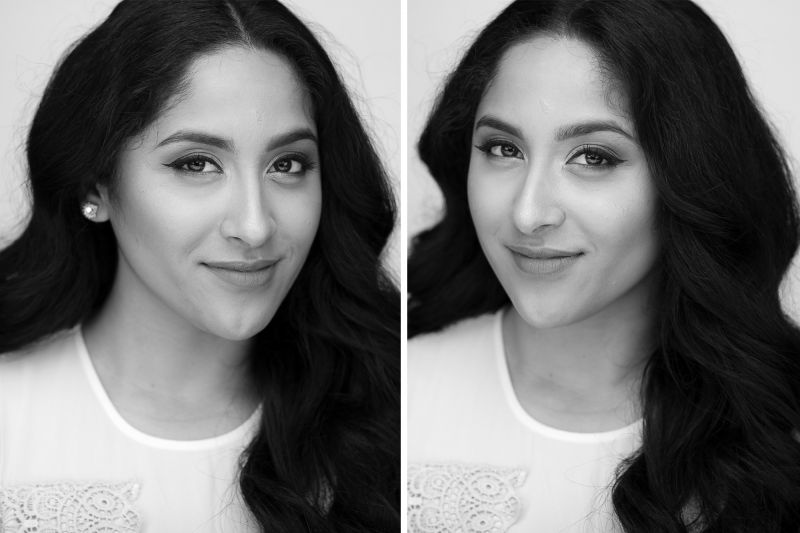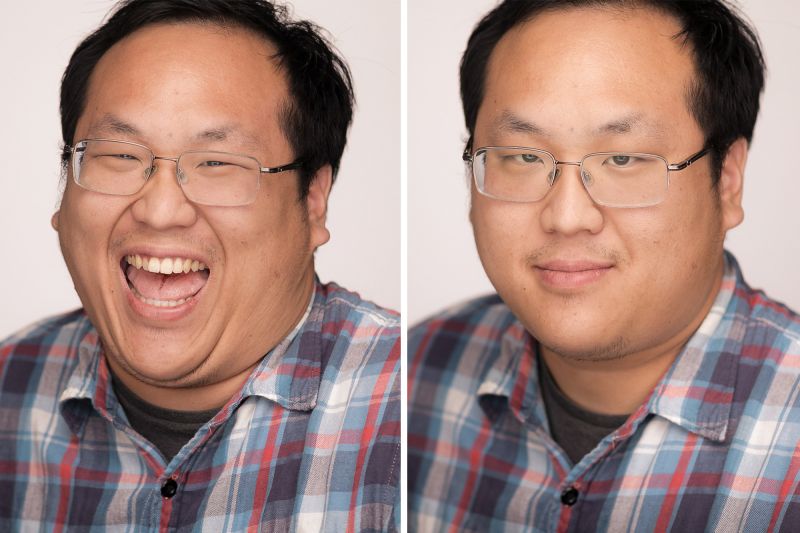
A headshot seems easy enough to photograph. I mean, it’s just a portrait of the client’s face, right? Actually, a headshot is more difficult than it seems. Remember that for actors/models/performers, their headshot is one of their most important tools of their trade. A headshot could mean the difference between a callback and booking the gig or just another photo in the rejected pile. Today, many fields also require headshots – from real estate to corporate CEOs, so headshot photography is a great field to look into if you are looking for an area to specialize in. In the following article, we’ll teach you how to pose for a headshot.
This education is from our Headshot Photography 101 workshop in SLR Lounge Premium.
Watch The Posture and The Spine in Headshot Photography

Although headshots don’t include much of the subject’s body, it is still important that subjects stand with good posture. Bad posture will reduce the subject’s presence in the frame. If you notice that your subject is slouching, make these three adjustments:
- Push in the lumbar (lower) spine so that the spine resembles a smiley face from the side
- Straighten the thoracic (middle) spine
- Straighten cervical (upper/neck) spine
A simple way to direct your subject into standing up straight is to tell them to imagine they are being pulled up by a “puppet string.” More often than not, this cue will help you get the posture you’re looking for.
Understand Broad Vs. Narrow Shoulders

The angle of your subject’s shoulders in relation to the camera will affect the subject’s appearance and presence in the frame. To increase your subject’s presence, position the shoulders so that they square up with or directly face the camera. Broader shoulders add a sense of strength to the subject. This rings true and works for both men and women. To soften or decrease your subject’s presence, angle the shoulders. Angled shoulders tend to slim down and soften subjects.
Work the Jawline

Angling your client’s face and tilting his or her head will help you accentuate your client’s jawline. To do this effectively, give subtle guidance and specifically say “tilt” in relation to tilting the head up and down and “turn” in relation to turning the neck left and right. It also helps to demonstrate what you mean as you direct your clients.
Ask the Subject to Extend the Neck

Extending your client’s neck for headshot posing can yield multiple benefits and eliminating extra time spent editing images in Photoshop. Some benefits include the following:
- Smooths skin
- Reduces/removes double chin
- Elongates neck
- Enhances jawline
Make sure the subject isn’t extending the neck too far though, as that can start to look unnatural in your posing. Demonstrate for him or her and experiment to get the best results.
Know When To Use Straight Vs. Angled Faces/Heads

There are several factors to consider when deciding whether to shoot your client’s headshots straight on or at an angle. As previously mentioned, turning a client’s face toward one side or the other creates a slimming effect and is generally more flattering. Shooting headshots straight on, however, tends to exaggerate the symmetry or dissymmetry in a face and can broaden a subject’s appearance.
Learn How to Find Their Side

Because headshots draw so much attention to a subject’s face, we want to be sure to capture the face from the best angle. In order to find your client’s side, we suggest you do the following:
- Ask, “Do you have a preferred side?”
- Look for the part in the hairline
- Do the finger test: Without telling the client why you’re doing it, ask the client to follow your finger with their chin as you move it from left to right and look for their most flattering angle.
Another way to find your client’s side is to view the headshot upside down. Viewing the image this way draws attention to exaggerated or asymmetrical features, such as uneven eyes or jawlines.
Find Their Confident Eyes – The “Peter Hurley” Squinch

Peter Hurley’s famous “squinch” (squint + pinch) involves subtly squinting the eyes to create a confident facial expression. Be sure to watch for forehead wrinkles when directing your clients to squinch. All other tips regarding angles and extending the neck still apply.
Direct into the Expression

Play into your personality when directing your clients into an expression. Avoid the usual cues like “Say cheese,” “Smile,” or “Act natural.” Instead, customize a traditional cue and complete the sentence, “Smile as if,” based again on your personality as well as that of the client. The best reactions will happen with more natural interaction.
Here are some ways to interact with your clients:
- Ask them to act
- Ask them to scream out loud
- Be goofy
- “Smile as if…”
Do what you can to get their mind off the shoot so that they can start feeling comfortable! If your interaction with the client seems to fall flat and chemistry is minimal, you might consider having music playing in the background to fill in the silent moments, or try to get to know them a little more.
Conclusion
Posing for any genre of photography is all about minding the details and practicing enough so that you start identifying and solving issues as they come up. Clients often don’t know how to achieve their desired look, so it’s your job to coach them into it. Hopefully this article helps you understand how to pose for a headshot with a solid foundation.
For more information, see our Headshot Photography 101 workshop in SLR Lounge Premium.





Get Connected!